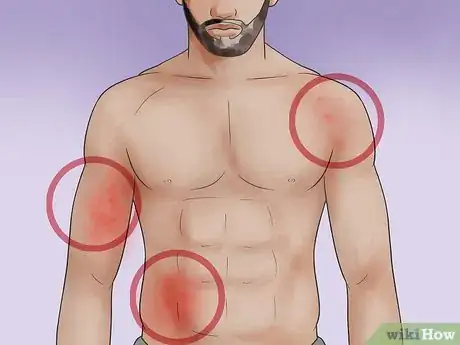This article was medically reviewed by Sarah Gehrke, RN, MS. Sarah Gehrke is a Registered Nurse and Licensed Massage Therapist in Texas. Sarah has over 10 years of experience teaching and practicing phlebotomy and intravenous (IV) therapy using physical, psychological, and emotional support. She received her Massage Therapist License from the Amarillo Massage Therapy Institute in 2008 and a M.S. in Nursing from the University of Phoenix in 2013.
There are 15 references cited in this article, which can be found at the bottom of the page.
This article has been viewed 22,798 times.
Skin cancer is the most common form of cancer, because the skin is the largest organ and it is in direct contact with the environment every day.[1] Early diagnosis is key when dealing with skin cancer. Working to prevent skin cancer is the best early defense against skin cancer. You can examine your own skin every month as well as ask your dermatologist if you find something you are unsure of. These methods will help you spot the early signs of skin cancer.
Steps
Performing a Self Examination
-
1Examine your body. The best way to find skin cancer early is to keep a check on any skin abnormalities through a monthly full body skin exam. Stand in front of a full length mirror. Examine the whole front of your body, checking each part of your body. Turn around and look over your shoulder, examining the back area of your body, paying special attention to the back of your legs. Next, raise your arms and examine your underarms, inner arm area, elbow, forearms, upper underarms, and palms.[2]
- Make sure you also look at the tops and bottoms of your feet.
- Using a hand mirror, check your buttocks, genitals, neck, and scalp.
- If there are areas you can’t reach, ask a loved one to help.[3]
-
2Track your changes on a mole map. As you examine your body, track your moles on a mole map. This map needs to be a representation of your body, with a front and a back, so you can keep track of where all your moles are. Each month, pinpoint where your moles are and write down the general appearance of them.
- The American Academy of Dermatology has a premade map that you can download every month as you do your examination.[4]
Advertisement -
3Look for problem moles. While making your examination, you need to watch for problem moles. You should notice is your moles change shape, size, or color, start to ooze or bleed, and feel itchy, swollen, or tender, or if the mole returns after it has been removed.[5] To keep track of problem moles, you need to follow the ABCDE rule. The rules to notice melanomas are:
- A: Asymmetry, when moles have different halves and one side looks different than the other.
- B: Borders, which tend to be ragged, irregular, or scalloped, and it may also have visible blood vessels around it.
- C: Color, which can be different shades of brown, tan, red, or black, with rare ones turning white.
- D: Diameter, which tend to be larger than 6 mm.
- E: Evolving, which means they change size, shape, and color over time, or have a shrunken center.[6]
-
4Repeat the exam once a month. In order to note the progress of your moles, you need to make sure you perform this examine once a month. This will ensure that you know how your moles are doing and you will be able to catch any changes as early as possible.
- Create a new map every month so you can notice any changes.[7]
Preventing Skin Cancer
-
1Use sunscreen. You can help prevent skin cancer by wearing SPF. You should apply SPF 30 or more to any area of your body that will be exposed to the sun. Use about one ounce of sunscreen to cover your skin every time you apply it.[8]
- You can wear a non-comedogenic moisturizer with sunscreen on your face to help your pores from getting clogged.
-
2Avoid peak sun exposure times. In order to help prevent skin cancer, you should avoid going outside during the times when the sun is at its peak. This is typically between the hours of 10 am and 4 pm. This is because the sun’s rays are most direct during this time of day.[9]
- If you have to be outside, try to stay in the shade as much as possible.
-
3Wear protective clothing. When you are going to spend a long time in the sun, you should wear protective coverings over your body. This means you should wear long pants, long sleeve shirts, hats, and sunglasses.[10]
- This will limit unwanted UV radiation exposure to your skin.
-
4Talk to your dermatologist. If you are not sure if your mole or skin area is skin cancer, make an appointment with your dermatologist. If you are at high risk, you should have regular exams with your dermatologist to keep track of it. If you have had severe sunburn recently, you may also need to get checked out.
- If your dermatologist is worried about a mole, you may need a shave biopsy to check the tissue.[11]
Understanding Skin Cancer
-
1Recognize melanoma skin cancer. Skin cancer can be divided into non-melanoma and melanoma skin cancers. Melanoma skin cancer is the dangerous kind. Your skin grows normally to naturally replace cells that die off. With cancerous cells, however, there is an uncontrolled growth of cells to form a solid tumor. These can be benign, which are not cancerous, or malignant, which are cancerous and can spread the cancer.[12] [13] Different types of melanoma skin cancer include:
- Atypical moles, also known as dysplastic nevi, which are larger than normal moles (greater than ⅓ inch or greater than 8 mm), have irregular or non-smooth edges, and are often darker than normal brown moles.[14]
- Actinic (solar) keratosis, which is a rough and scaly patch of skin that has often been exposed to the sun, most commonly found on the face, ears, lips, scalp, neck, back of your hands, and forearms, and that get bigger over time.[15]
-
2Notice non-melanoma skin cancer. Non-melanoma skin cancers are the most common forms of skin cancer. Almost all of these forms of skin cancer can be cured, with better chances of a cure arising if you spot them early. The different forms of non-melanoma skin cancer are:[16]
- Basal Cell Carcinoma (BCC), which is commonly found on the head, face, arms, neck, and hands, looks like waxy, raised, small, pearly bumps, grows slowly and rarely spreads.[17]
- Squamous Cell Carcinoma (SCC), which is found on the neck, face, arms, head, and hands, is scaly and rough, reddish in color, and rarely spreads to other parts of the body.
- Merkel Cell Carcinoma (MCC), which is a less common and very fast growing skin cancer, shows up as firm, shiny lumps on the skin with a reddish, pinkish, or bluish color, and do not hurt but may be tender to the touch.
- Cutaneous T cell Lymphoma, which starts in the blood, appears as scaly or bumpy patches on the skin, and is very slow growing.
- Kaposi’s Sarcoma, which is usually associated with HIV/AIDs, is purplish in color, and appears as a flat patch of skin or inside the mouth, nose, or throat.
-
3Decide if you are at risk. There are certain situations that make you more at risk for skin cancer. These will make you more susceptible to skin cancer, which means you need to be more careful with your skin and try as many of the preventative methods as possible. These risks include:[18]
- 10 or more atypical moles, causing a higher risk of melanoma
- Excessive sun exposure
- Blond or red hair
- Blue or green eyes
- Fair complexion
- Family or personal history of melanoma
- Excessive ordinary moles (more than 50) or having many freckles
- Immunosuppressive disorders
- Early childhood sunburns
- Inability to tan
- History of tanning bed use[19]
- Advanced age[20]
-
4Notice the causes of cancer. There are a few causes of skin cancer, and some situations where the cause is unknown. The most common cause is excessive sun exposure, which is ultraviolet or UV radiation. [21] In other cases of skin cancer, the exact cause is unknown but is typically caused by a combination of factors that may include diet, genetic factors, lifestyle choices, viral infections, and environmental carcinogens.
References
- ↑ http://www.hopkinsmedicine.org/healthlibrary/conditions/adult/dermatology/understanding_the_types_of_skin_cancer_34,AMelD4/
- ↑ https://www.mayoclinic.org/diseases-conditions/skin-cancer/symptoms-causes/syc-20377605
- ↑ https://www.aad.org/public/spot-skin-cancer/learn-about-skin-cancer/detect
- ↑ https://www.aad.org/public/spot-skin-cancer/learn-about-skin-cancer/detect/body-mole-map
- ↑ https://www.aad.org/public/diseases/skin-cancer/basal-cell-carcinoma#symptoms
- ↑ https://www.aad.org/public/spot-skin-cancer/learn-about-skin-cancer/detect/what-to-look-for
- ↑ https://www.aad.org/public/spot-skin-cancer/learn-about-skin-cancer/detect/what-to-look-for
- ↑ https://www.cdc.gov/cancer/skin/basic_info/sun-safety.htm
- ↑ https://www.cdc.gov/cancer/skin/basic_info/prevention.htm
- ↑ https://www.cdc.gov/cancer/skin/basic_info/prevention.htm
- ↑ https://www.aad.org/public/spot-skin-cancer/learn-about-skin-cancer/detect
- ↑ http://www.cancer.gov/about-cancer/what-is-cancer
- ↑ http://www.cancer.org/cancer/cancerbasics/index
- ↑ https://www.cancer.gov/types/skin/moles-fact-sheet
- ↑ http://www.mayoclinic.org/diseases-conditions/actinic-keratosis/basics/definition/con-20030382
- ↑ https://www.nhs.uk/conditions/non-melanoma-skin-cancer/
- ↑ https://www.aad.org/public/diseases/skin-cancer/basal-cell-carcinoma
- ↑ https://www.cdc.gov/cancer/skin/basic_info/risk_factors.htm
- ↑ https://www.aad.org/public/spot-skin-cancer/learn-about-skin-cancer/detect/what-to-look-for
- ↑ http://www.hopkinsmedicine.org/healthlibrary/conditions/adult/dermatology/understanding_the_types_of_skin_cancer_34,AMelD4/
- ↑ https://www.mayoclinic.org/diseases-conditions/skin-cancer/symptoms-causes/syc-20377605
- ↑ http://www.cancer.gov/about-cancer/what-is-cancer
- ↑ http://www.cancer.org/cancer/cancerbasics/index

















-Step-13.webp)





-Step-8-Version-3.webp)











































Medical Disclaimer
The content of this article is not intended to be a substitute for professional medical advice, examination, diagnosis, or treatment. You should always contact your doctor or other qualified healthcare professional before starting, changing, or stopping any kind of health treatment.
Read More...